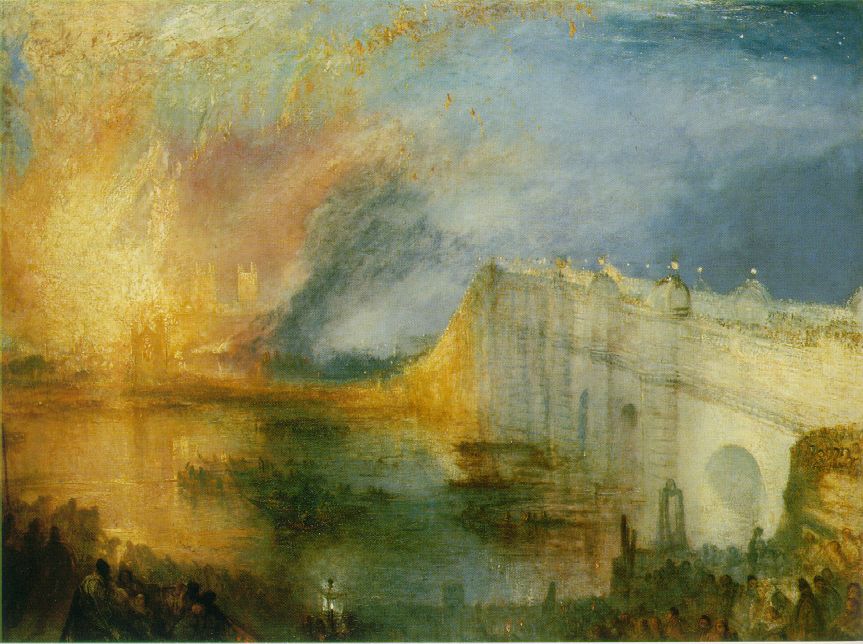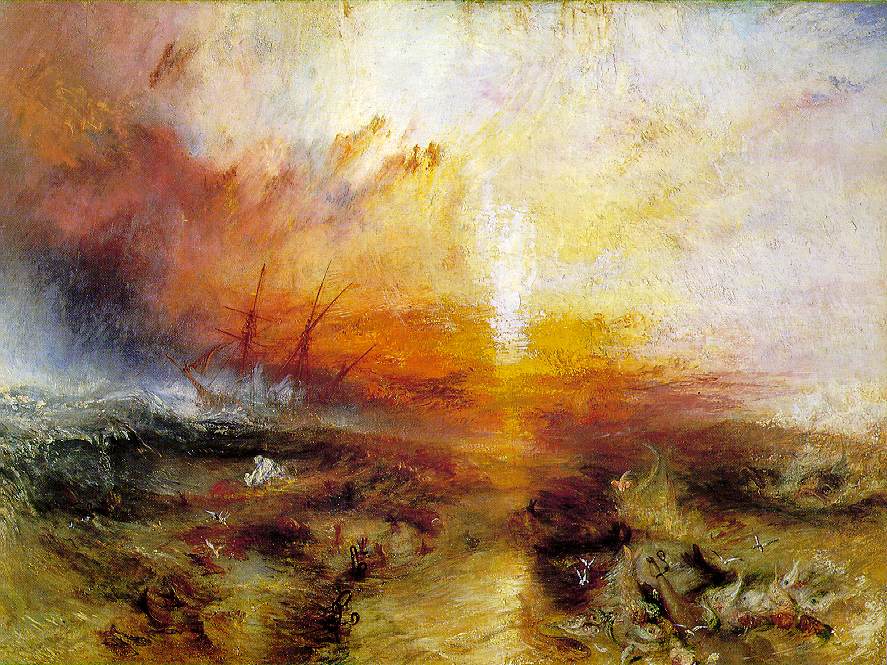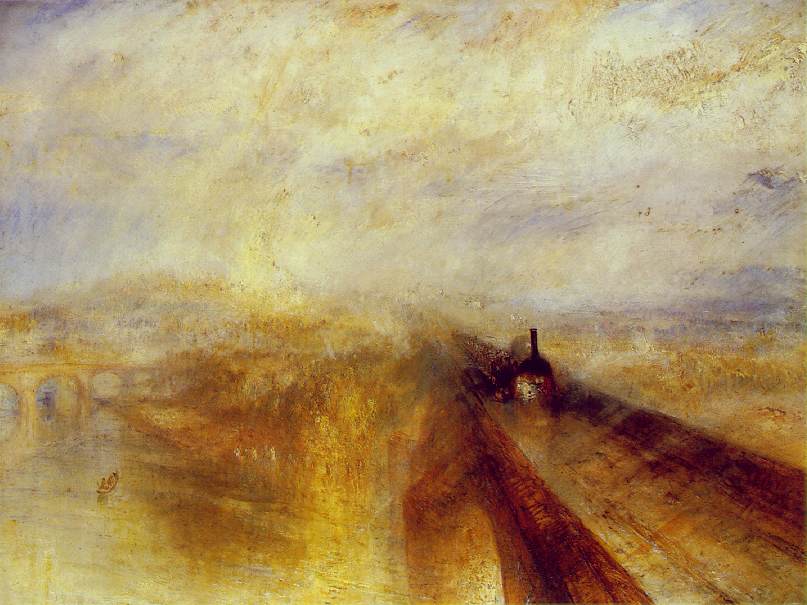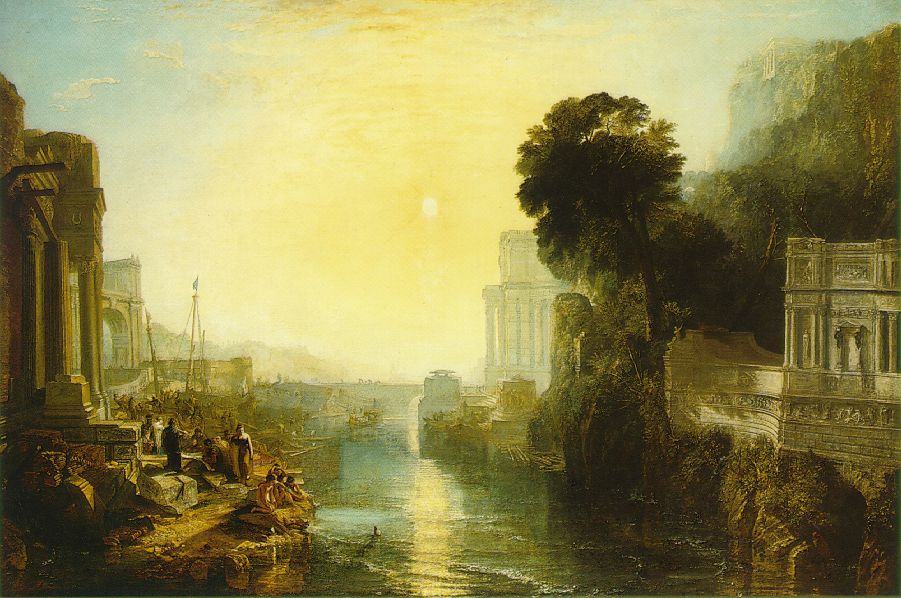 |
| Self portrait, oil on canvas, circa 1799 link to source |
Joseph Mallord William Turner was born April 23, 1775, in
London’s Covent Garden district. He was an extremely precocious artist, shown
by his admittance to the Royal Academy School at age 14 and his ascension to a
full member of the academy by age 26. Starting in 1791, Turner traveled
throughout Britain, visiting Bristol, Wales, Kent, Sussex, the Midlands, the
Isle of Wright, and the Lake District. He drew and painted nature and famous
sites, and studied works on view in Britain’s great houses. He enjoyed great artistic
success during his life. He began showing at newly-created British Institute as
well as the Royal Academy, and was able to travel extensively throughout
Europe. He died at age 76 on December 19th, 1851. Despite a celebrity
status, he kept his life private, and it was not until his death that that it
was revealed he had two daughters by the widow of a composer named Sarah Darby,
and that he had been carrying on a relationship with one of his landladies,
Sophie Booth, for the past 18 years. He was one of the first artists to set out
a wish in his will for a gallery to house his works to be built after his
death.
In his youth, J. M. W. Turner worked with Thomas Girtin and
the two of them helped establish watercolor as a reputable art form. Watercolor
was Turner’s first medium and would remain his medium of choice throughout his
career. He became known for his watercolors before deciding to master oils, but
he often returned to watercolor. Turner focused on light in his artwork, using
bright colors like yellow and washes of paint to give his paintings an
atmospheric quality. He found inspiration in sunsets, fires, rain, and fog, as
shown by the selected pieces below. One his most famous series is his paintings
of the Burning of Parliament in 1864, when the Parliament building in London
caught fire and burned to the ground. He witnessed the event first-hand, and
painted scenes of it blazing across the river from memory. His later works are
very expressionistic, with soft, blurred lines and bright, vivid colors. He
would later serve as inspiration to an influential group of painters known as
the Impressionists, as well as to a group of American landscape painters known
as the Hudson River School. Such artists as Monet, Pissarro, Felix Ziem, Thomas
Cole, and John Martin were all influenced by Turner’s style, and much of modern
cinematography, from Cecil B DeMille to the Lord of the Rings trilogy, shows
Turner’s influences.
I choose Turner because I was drawn to his expressionistic
style of painting and his focus on light. His paintings appear dream-like to
me, but with more of a real base than the Impressionists, Post-Impressionists,
and Expressionists. The subjects of his paintings are finely detailed, but as
the objects retreat into the distance the details vanish and become very
surreal.
 |
| The Burning of the Houses of Lords and Commons, 16th October, 1834 1835; Oil on canvas, 92 x 123 cm; Philadelphia Museum of Art link to source |
Turner's loose style is reflected in two of his more famous pieces, Rain, Steam, Speed, which depicts a steam engine traveling over a bridge, and Slavers throwing overboard the Dead and Dying - Typhon coming on ("The Slave Ship").
 |
| Slavers throwing overboard the Dead and Dying - Typhon coming on ("The Slave Ship") 1840; Oil on canvas, 90.8 x 122.6 cm; Museum of Fine Arts, Boston link to source |
 |
Rain, Steam and Speed
1844; Oil on canvas, 90.8 x 121.9 cm; National Gallery, London
|
His earlier work was much tighter and more exact, as shown by Dido building Carthage; or the Rise of the Carthaginian Empire.
 |
| Dido building Carthage; or the Rise of the Carthaginian Empire 1815; Oil on canvas, 155.5 x 232 cm; National Gallery, London link to source |
My favorite Turner work is The Fighting "Temeraire" tugged to her last berth to be broken up, as it beautifully captures the sun setting on the sail-powered ship being pulled to harbor by the steam-driven tug.
 |
| The Fighting "Temeraire" tugged to her last berth to be broken up 1838; Oil on canvas, 91 x 122 cm; National Gallery, London link to source |
References:
Meslay, Oliver. J. M. W. Turner The Man Who Set Painting on Fire. London: Thomas & Hudson Ltd, 2005. Print.
No comments:
Post a Comment